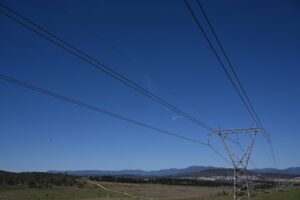
Late last week, set among Hangzhou’s ancient gardens and shimmering new buildings, China and the U.S. announced that they are formally joining the Paris agreement to combat climate change. It was the latest demonstration of joint leadership by the two countries on global climate and environmental issues.
For China to meet its own targets—especially peaking carbon emissions by 2030—it must aggressively transition away from an economy built on fossil fuels. Back in June 2014, President Xi Jinping called for “a revolution in the production and consumption of energy.”
And a revolution is needed. The country holds too many undesirable titles in a world recently committed to leaning its fossil fuel diet: the world’s largest carbon emitter, largest coal consumer, and largest net importer of oil. But the call for a revolution comes at a challenging moment for China; between 2010 and 2030, China will need to reduce its emissions, transition nearly an entire U.S. population from rural to urban living, and grow its economy several times over, in accordance with its planning goals.
Reinventing fire: China key findings
Back in 2011, RMI published a roadmap for the U.S. to kick its dependence on fossil fuels by 2050, entitled Reinventing Fire. In 2013, we started on similar research for China by partnering with three leading organizations: the Energy Research Institute of China’s National Development and Reform Commission (ERI), Lawrence Berkeley National Laboratory (Berkeley Lab), and Energy Foundation China (EF China).
Reinventing Fire: China answers President Xi’s call with detailed, scientific research that supports a revolutionary pathway toward a sustainable, clean energy system. This groundbreaking publication—the result of an unprecedented cross-Pacific collaboration—demonstrates how China can reduce its carbon emissions by 42 percent below 2010 levels by 2050 and grow its economy 600 percent while saving a net $3.1 trillion over the investments required. Three years of research by 50 scientists lay out a pathway in which:
1) China can peak its carbon dioxide emissions by 2025.
China is the world’s largest carbon emitter. Yet per capita carbon emissions remain low compared with more developed economies, such as the U.S. This means that as China’s economy grows, carbon emissions could follow. Peaking China’s carbon emissions is vital to combat climate change. In Reinventing Fire: China, we show a pathway for China to decouple economic growth from carbon emissions. China can peak emissions 11 years earlier and 30 percent lower than the reference scenario. To do so, China must take advantage of cost-effective and commercially available technology (Reinventing Fire: China does not include far-fetched ideas or immature technologies; in fact, we only considered technologies that make commercial sense today).
2) China can decouple its economic growth from intense energy use.
As China’s economy grew by leaps and bounds over the past 35 years, so did its energy use. Averting similar future energy growth is a prerequisite to peaking carbon emissions and putting the country on a low-carbon pathway. Although the country has vast coal resources, it is a net importer of oil and natural gas. Burning dirty fuels not only pollutes China’s air and water, relying on imports of these fuels is a national security risk. Reinventing Fire: China lays a path for China to use the same amount of energy in 2050 as it did in 2010, while still growing its economy six times and providing a better standard of living for its people. This is accomplished by reducing end-use demand in the three main sectors of the economy—industry, buildings, and transportation—and using smart growth strategies as the country becomes wealthier and continues to urbanize.
3) China can significantly increase use of non-fossil energy.
Stemming the growth of energy use is just the first step. The next step is to dramatically increase the use of non-fossil energy resources. Replacing fossil-based energy with clean alternatives, such as wind, solar, and hydropower, shifts China’s electric grid from being over three-fourths fossil generation in 2010 to being 82 percent non-emitting by 2050. As the electric grid is powered more by clean energy, it also makes more sense for China to electrify its economy as an accelerant to decarbonization. For example, a cleaner grid means electric vehicles powered off it would be fueled by the wind and sun rather than gasoline, making it easier for China to achieve its peaking goals. Beyond these energy benefits, this shift has numerous additional, tangible effects that are not valued in our analysis but are worth mentioning: Specifically, we did not put an economic value on the positive impacts to public health or the environment.
4) China can dramatically reduce its coal consumption.
In 2050, with the same energy demand as 2010 but substantially more non-fossil energy use, China can largely abandon the coal that plagues its cities, rivers, and skies. Though the country has an abundance of the fuel, the continued use of coal puts the entire world in jeopardy. By fuel switching—the process of replacing dirty fuels with cleaner sources—China can use 60 percent less coal in 2050 than it did in 2010. As the largest single user of coal, any cuts China makes in coal use have a substantial impact on global emissions. Similarly, oil demand, which grew by double digits over the past few decades, is 22 percent lower in 2050 than in 2010 and natural gas demand is 61 percent lower.
5) China’s transition to low-carbon development is a net benefit to the economy.
The results laid out above would be unattainable if they weren’t practical, driven by today’s commercially available technology, and economic. In fact, the results of the Reinventing Fire: China pathway are a boost for the economy, providing a net savings of 21 trillion RMB ($3.1 trillion) between 2010 and 2050. But the Reinventing Fire: China pathway is not the business-as-usual scenario; it requires upfront investment of 35 trillion RMB ($5.2 trillion), which in turn, yields savings of 56 trillion RMB ($8.3 trillion).
As a result of the announcements by China, the U.S., and others, a renewed optimism that the world can unite to fight climate change prevails. But, as President Xi declared at the summit, we all must move from talk to action. Reinventing Fire: China provides a practical roadmap with steps China can take to tackle climate change while simultaneously spurring economic growth. It shows how efficiency paired with renewables is a compelling path to start on today—a path worth following not just for China, but for every country committed to achieving the Paris vision and possessing a Hangzhou-style readiness for action.
Download the Reinventing Fire: China Executive Summary
Source: RMI. Reproduced with permission.













